1.
The following are household furniture except
bookshelve.
cabinet.
chair.
television.
2.
The shape of a developed open-ended cylinder is a
circle.
parallelogram.
rectangle.
rhombus
3.
The plug is fused in order to
break when there is excessive current.
increase the flow of electricity.
oppose the flow of electricity.
stop the flow of electricity.
4.
Evaluations are carried out on an artefact in order to
change the situation completely.
conduct a new research of the design.
increase the cost of artefact.
make modification on the design.
5.
Use Figure 1 below to answer the question that follows.
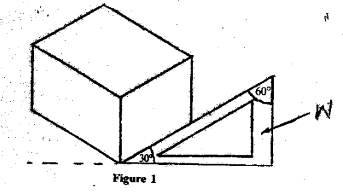
Figure 1 shows an object drawn in
isometric.
oblique.
orthographic.
perspective.
6.
Use Figure 1 below to answer the question that follows.

The instrument labelled W is
protractor.
rule.
set square.
tee square.
7.
The traditional form of food preservation in Ghana is
bottling and freezing.
freezing and drying.
drying and salting.
salting and bottling.
8.
A birthday cake is usually packed in a brown cardboard box
to attract customers.
for easy transportation.
to preserve flavour.
to give information.
9.
A light meal eaten between the main meals of the day is referred to as
elevenses.
high tea.
brunch.
snack.
10.
In table setting, the main reason for covering the table with a cloth is to
make the setting formal.
protect the table surface.
make the table attractive.
act like a silencer.
11.
An example of a wet medium is
chalk.
coloured pencil.
crayon.
poster colour.
12.
What are the primary colours of pigment?
Red, yellow, green
Red, blue, green
Yellow, blue, green
Red, yellow, blue
13.
Growth is symbolically represented with the colour
green.
red.
yellow.
white.
14.
Placing value on an item is termed
costing.
labelling.
pricing.
selling.
15.
Where the sky appears to meet the land is called the
horizon.
foreground.
background.
plane.
16.
Lacquer is diluted for easy application with
17.
The instrument used for transferring measurements from the rule to the drawing paper is a
Pair of compasses.
Pair of dividers.
Set square.
Tee square.
18.
Injury to the head at a work site is mostly caused by
falling objects.
inflammable materials.
slippery floor.
wearing loose clothing.
19.
The tool used for cutting sheet metal is
Crosscut saw.
Dovetail saw.
Scriber.
Snips.
20.
Which of the following methods of fastening makes a temporary joint?
Riveting.
Screwing.
Soldering.
Welding.
21.
In drawing, hidden details are shown by
continues thin lines.
long dashes.
short dashes.
thick chain lines.
22.
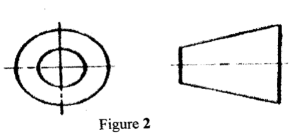
Figure 2 shows a symbol for
first angle orthographic projection.
third angle orthographic projection.
isometric projection.
oblique projection.
23.
Turpentine is used for thinning
emulsion paint.
oil paint.
wax polish.
white glue.
24.
Use Figure 3 to answer the question below.
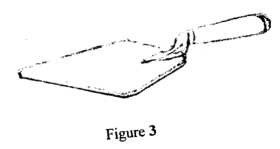
The tool shown is a
bolster.
float.
spade.
trowel.
25.
Use Figure 3 to answer the question below.

The tool is used for
aligning blocks.
checking courses.
holding mortar.
spreading mortar.
26.
The tool used for smoothening curved edges of wooden furniture is
chisel.
plane.
rasp.
saw.
27.
Which of the following is a ferrous metal?
Aluminium
Cast iron
Copper
Tin
28.
Which of the following wires helps to prevent shock when using an electrical appliance?
Earth wire
Fuse wire
Live wire
Neutral wire
29.
The source of electrical power in a simple circuit is
battery.
bulb.
capacitor.
switch.
30.
Horizontal lines are drawn with a
clip.
protractor.
set square.
tee square.
a)
Define a seam in clothing construction.
b)
Give one example each of the following.
i)
α)
Conspicuous seam
β)
Inconspicuous seam
ii)
List two moist methods of cooking.
c)
i)
List the two types of perspective drawing.
ii)
List three types of pictorial drawing.
iii)
State two stages in the design process.
d)
i)
Explain the spectrum of colour.
ii)
List the secondary colours.
iii)
Explain the term complementary colours.
Figure 1 shows the plan of a hexagonal pyramid.
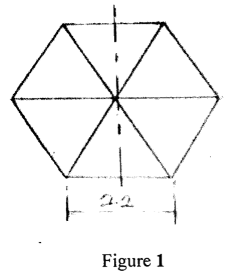
a)
Draw the following:
i)
The given plan.
ii)
Front view of the pyramid with a vertical height of 75 mm;
iii)
Surface development of the pyramid without the base.
b)
State the reason why each of the following safety clothing are worn in the workshop.
i)
Mask;
ii)
Helmet.
a)
i)
Sketch in two-dimensions, a three course block wall in stretcher bond. Length, four full blocks.
ii)
Re-arrange the following steps to be followed in laying the first course of a three course block wall;
I. Lay end blocks;
II. Fill mortar joints;
III. Set out and mark the position of wall;
IV. Spread mortar evenly;
V. Plumb and check alignment of wall;
VI. Gauage end blocks;
VII. Lay remaining blocks.
iii)
List three tools which would be used to set out and mark out the position of the wall in (a)(i).
b)
i)
Make a freehand pictorial sketch of a try square.
ii)
Label two main parts of the try square sketched in b(i).
iii)
State one use of the try square.
a)
Figure 2 shows a set up for an operation woodwork.
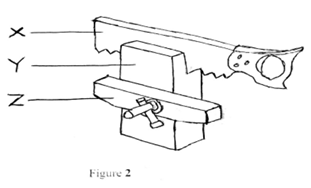
i)
Write the name of the operation being carried out in Figure 2.
ii)
Identify the items labelled X, Y and Z.
iii)
Make a pictorial drawing of the item labelled X.
b)
The table below shows two materials to be joined with an adhesive and be completed with a suitable finish.
Copy and complete the table with the appropriate responses.
| MATERIALS TO BE JOINED | ONE ADHESIVE MATERIAL | ONE SUITABLE POLISH |
| (i) Odum to Odum | ||
| (ii) Formica to Wawa | ||
| (iii)Veneer to Odum |
c)
Copy and complete the table shown below:
| METAL | ONE EXAMPLE | ONE PROPERTY | ONE USE |
| (i) Ferrous | |||
| (ii) Non-Ferrous |